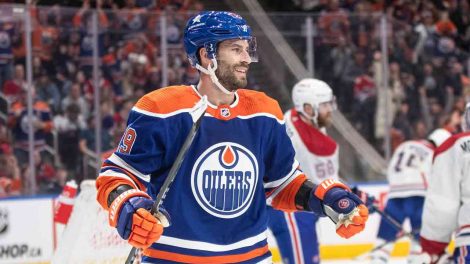NEW YORK – In signing a “Declaration of Principles” into being on Wednesday morning, stakeholders from 17 hockey organizations endeavoured to establish an internal compass to help guide decisions about the sport.
It may not be long before their shared direction is tested.
Of particular interest is the possibility of shifting the NHL’s draft-eligible age from 18 to 19 – a topic that has been discussed behind closed doors for a couple years now and a change that would be endorsed by Hockey Hall of Famer Pat LaFontaine, among others.
LaFontaine is also the driving force behind the new declaration, which outlines eight principles designed to create the best possible experience for the hockey community. He believes that document points towards a need to establish an extra year of development for young players.
“I think if you live the principals in which we believe in, and we all just signed to support, we have to look at ‘Is what we’re doing in the draft the right thing for age-appropriate (development)? And would an older draft be beneficial for the well-being of our game?”’ LaFontaine said in an interview. “That’s the question we have to ask ourselves. And I think when we look at it – you look at the way hockey is today – relieving maybe some of that pressure and pushing the dial of development to the right on all levels would benefit the experience (of players and their families).”
That kind of change would send a ripple effect across the industry.
It would likely see many players spend an extra year in midget before jumping to the Canadian Hockey League. The CHL, NCAA and European leagues would hang on to more prospects longer as well.
Standing in opposition to the idea is the NHL Players’ Association, which generally frowns on extra limitations being placed on work conditions. A change to the draft age must be collectively bargained so it’ll likely be a couple years – at minimum – before it happens.
Still, the discussion about a 19-year-old draft remains very much open. And it highlights the kind of tangible impact the “Declaration of Principles” might eventually produce.
The document was born after LaFontaine attended a sports summit at the Vatican last year and recently drew praise from Pope Francis, who sent a note to the NHL commending hockey leaders for undertaking the initiative.
“Not a bad letter, eh?” said LaFontaine. “We’ve got a fan in the Vatican.”
The challenge now is putting an abstract set of principles into practice. It’s one that is shared by stakeholders throughout the sport.
They exuded a mix of enthusiasm and pride while walking up to the stage on Wednesday to publicly sign off on the “Declaration of Principles.”
Tougher days lie ahead, especially when tackling issues like the NHL draft age where individual interests don’t completely align, but that’s an understood part of what everyone has signed up for.
The main tenets of the document are largely focused on the grassroots of the game – making it clear that hockey is a family sport welcome to everyone and a place where players develop character and life skills in addition to experiencing the positive aspects of physical activity.
While the initiative celebrates the unique culture around the sport – “We have a special community; the way I think we treat the game,” said Ottawa Senators captain Erik Karlsson, on hand for the announcement – its very existence implies that some areas need attention and improvement.
“I think that this transcends hockey,” said NHLPA executive Mathieu Schneider. “To me, this is about sport and the future of our kids. Being a parent, having gone through the hockey system but also having kids playing other sports, the things that we’re trying to deal with as parents today, there are common themes or common threads throughout.
“The idea that we’re putting kids in the sport for college scholarships and/or to become professional athletes was never the intention when we were kids. When we were kids growing up, it was about the health and what sport was able do, what sport was able to give to you.”
LaFontaine is a father of three himself who is nearly 20 years beyond playing his last NHL game.
He is still involved in hockey today because “I had an age-appropriate experience, emotional connection and great environment at every age group.” Now he sees an era of specialized coaching and year-round on-ice training, and concedes that “I’m not sure we’re delivering that when a kid hits a certain age.”
It was roughly three years ago that NHL deputy commissioner Bill Daly tasked LaFontaine with finding a way to get hockey stakeholders to work better together.
[relatedlinks]
“We talked sincerely about where our culture was,” LaFontaine recalled. “At the very highest levels we’re amazing at developing, but we also kind of looked at how maybe we can support and be better at supporting the growth of our game in all levels of the game.
“We realize that the leadership can be responsible for helping support those decisions, and we are responsible for those decisions. We listened to the hockey world.”
The unprecedented level of co-operation prompted NHL commissioner Gary Bettman to hail Wednesday’s unveiling as “an important day in the history of hockey.”
It felt more like a beginning than an arrival. The hockey world has established a high bar for itself and it’s gone public with its aspirations.
“What happens next?” said Schneider. “That’s what’s going to be the big thing.”








